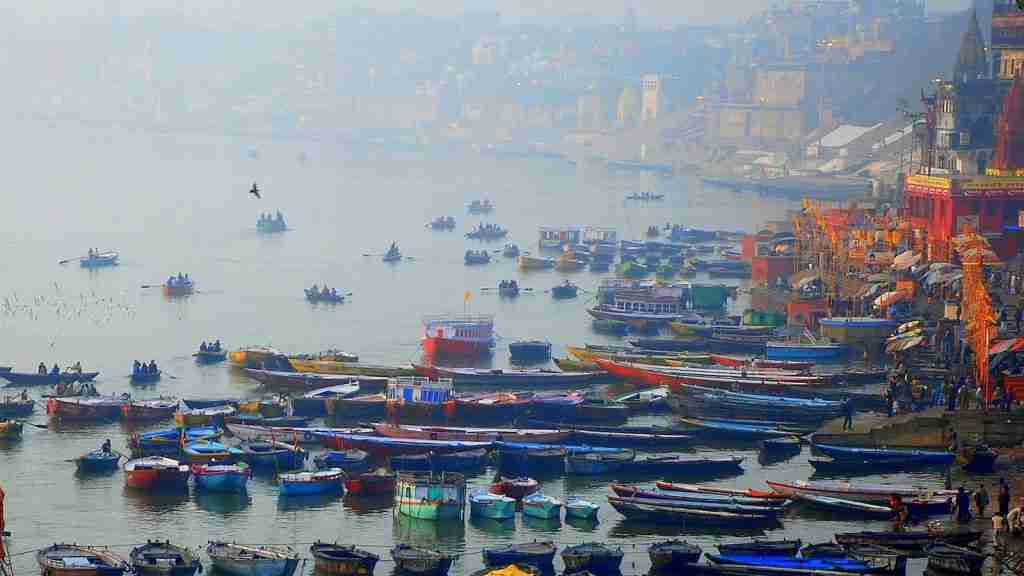22 Facts About the Ganges River (Let’s Dive In)
1. The Ganges River is the Longest River in India, stretching over 1,560 miles.
The Ganges River is a 1,560-mile-long river that runs through India, originating in the majestic Himalayas. As it snakes its way southwards, the majestic river maintains its course for hundreds of miles.
During this stunning journey, travelers can witness ever-changing landscapes and countryside from one side of the country to the other. The remarkable journey eventually concludes near the Bay of Bengal, which marks its grand mouth opening.
2. The Ganges River is considered one of the Holiest Rivers in Hinduism.
The Ganges River carries unparalleled religious significance within the Hindu faith. It is thought to be one of the holiest rivers in the world and is even seen as divine: a manifestation of the Goddess Ganga.
Hindus refer to her with great respect and reverence. Many holy sites exist alongside her banks, often visited by many pilgrims from throughout India intertwined in prayer and worship.
3. The Ganges River is the Source of Water for over 500 million people in India and Bangladesh.
The Ganges River, with 500 million people in India and Bangladesh depending on it, is understandably heavily populated. Its vast size is like an ocean of mercy, sustaining countless communities with fresh water from its source over great distances.
For centuries, this great body has been a source of solace, meeting the basic needs of an unimaginable number of people. Revered in Indian culture, the Ganges flows through a densely populated area, similar to the Nile, which is a vital lifeline for millions in Egypt.
4. The Ganges River is Home to a Diverse Array of animal life.

in the Ganges River.
The Ganges River hosts a multitude of different animals, harboring numerous creatures that are endemic to the region. Among many others, this river provides a home for the highly endangered Gangetic dolphin.
Additionally, the Ganges Shark and Ganges River Turtle are two other species that have made this physique of water their habitat.
5. The Ganges River is a Major Transportation Route in India.
Majestically calling home over 58 towns, the Ganges River is India’s lifeline for transporting both goods and people. Its lengthy journey starts from an elevation of 2,600 meters in the Himalayas and terminates at Bangladesh’s Bay of Bengal at a mere 33cm altitude.
Along its banks are a network of busy ports enabling large barges and small farm boats to travel up and down its path, facilitating regional trade efforts.
6. The Ganges River is an Important Source of Irrigation for Agriculture in the region.
The Ganges River is deeply intertwined with the life and culture of the region. Beyond its spiritual and historical significance, it’s a lifeline for agriculture, supporting some of India’s most fertile lands.
Key crops like rice, wheat, and sugarcane thrive in its basin, thanks to the river’s irrigation capabilities. Its role extends to transportation and commerce, with cities and towns along its course serving as crucial trading centers.
7. The Ganges River is Heavily Polluted, with Untreated Sewage and Industrial Waste.
The Ganges River, widely venerated in Hinduism for its sacred waters, is now heavily polluted. Unsustainable development and industrial activity have taken a toll on its waters.
Untreated sewage and industrial waste are often discharged directly into the river, causing severe damage to both human health and the environment alike. Once flowing with pure blue water, images taken today reveal a murky brown river due to widespread contamination.
8. The Ganges River has a Rich History, with ancient Hindu Texts and Legends associated with the river.

The Ganges River, steeped in a rich history, finds its narrative woven into ancient Hindu texts and legends. Renowned poems like Ganga Lahiri and Ganga Avataram celebrate its sacred waters, while mythological tales, such as the purifying touch of Lord Shiva’s Ganga descent, further enhance the river’s mystical significance.
This cultural tapestry of verses and legends continues to shape the profound reverence that the Ganges command in Hindu traditions.
9. The Ganges River, mentioned in the Vedas, is believed to cleanse sins.
The Ganges River has loomed large in the Hindu religion for thousands of years. It is widely mentioned in inscriptions, such as the Vedas, and is revered for its special powers to bring absolution from sinful behavior.
Ancient beliefs recognize this sacred body of water as a cleansing force, enabling those who dip their toes into its waters to wash away their past wrongs. Many still congregate around it today to say prayers and be immersed within this incredible resource, hoping that it brings with it spiritual renewal.
10. The Ganges mysteriously disappears underground in places, creating the disappearing river phenomenon.
In some areas, the Ganges River takes a surprising turn by vanishing beneath the earth’s surface, leading to what’s known as the disappearing river phenomenon.
This happens when the river’s water flows into hidden channels or caves within the ground, a natural process influenced by the riverbed’s geological structure. Over time, erosion and the type of rocks in these areas allow the water to seep down, only to reappear further downstream.
11. The Ganges River is believed to originate from the matted hair of the Hindu deity Lord Shiva.
According to Hindu mythology, the Ganges River, revered as a celestial entity, descended to Earth with such force that it threatened to devastate the land. To mitigate this, Lord Shiva captured the river in his matted locks, allowing it to flow gently through his hair and down the Himalayas.
This story encapsulates the river’s profound sanctity and significance to the people, illustrating its role not just as a physical entity but as a divine symbol of life, purity, and grace that sustains and nurtures the land it traverses.
12. The Ganges River is also home to a number of important Hindu festivals and ceremonies.
The Ganges River is no stranger to religious rituals and festivities. A particularly important one, Kumbh Mela, takes place every twelve years. Hindus gather around its banks in reverence for their faith and its role in their spiritual lives.
No other river carries the same cultural significance as the Ganga does. The water of life and humanity’s indisputable importance meld together at Kumbh Mela – a holy congregation like no other celebrated in India.
13. Many believe a dip in the Ganges purifies the soul, as the river is sacred in Hinduism.
The Ganges River has been an object of reverential awe to the Hindu faith for millennia. It is thought that by taking in its waters, one can discover a special kind of inner peace and purification.
Those who participate in the ritual say it is transformative, providing them spiritual solace even during difficult moments. Steeped in tradition, it has become a multigenerational custom within tribe cultures up and down existing riverside communities.
14. Fishing and boating are major industries along the Ganges, providing livelihoods for many in the region.
The Ganges River is more than just a source of life – it’s an important source of livelihood, too. Fishing and boating are major industries that rely on the river to sustain them, with local people benefiting greatly.
You can see wooden fishing boats set out cheerily above the wave tops along the waterway, their owners hoping for frequent catches. People in this area rely upon the sea to offer them additional income to support their families, diving into fresh waters with trusty nets in their arms.
15. The Ganges River is also Home to a number of threatened plant species.

The Ganges River contains a remarkable array of plant species, some of which are even considered to be threatened due to population decline within the river and its surroundings.
Among these species are two of the most well-known: the sacred lotus and the water lily. Such reverence for such plants is held all throughout India.
16. The Ganges has an untapped hydroelectric potential of 51,500 to 128,500 megawatts.
The Ganges River holds a vast potential for hydroelectric power, estimated to range from 51,700 to 128,700 megawatts.
This untapped energy source represents a significant opportunity for sustainable development, particularly in regions along the river that are in dire need of clean and renewable energy solutions.
17. The Ganges River is also a Popular Destination for Rafting and other Adventure Sports.
The Ganges River is renowned for its beauty and significance, often regarded as a holy destination to seek spirituality. Thanks to its vastness, it’s an ideal destination for thrilling river rafting and boating adventures.
The river supports a rich ecosystem home to various plant and animal life, including the endangered Ganges River dolphin. The river also provides water for agriculture and serves as a source of livelihood for many communities along its banks.
18. Hindus believe that immersing ashes in the Ganges ensures a direct path to heaven.

In Hindu culture, the Ganges River is of immense spiritual significance. Immersing ashes in its holy waters aids the departed soul in finding peace and avoiding a return to its previous life. The river’s sacred water cleanses the deceased of sins and protects the family from supernatural disturbances.
The ritual is complemented by scientific reasons, as human ashes contribute to soil fertility. Funeral direction teams assist families in performing this ritual, ensuring a dignified ceremony.
19. The Ganges creates the world’s largest delta, the Sundarbans.
The Ganges River flows into the Bay of Bengal, where it merges with the Brahmaputra River, together forming the Sundarbans Delta, the largest delta on the planet.
This vast and fertile region is not only a critical habitat for a wide range of wildlife, including the famous Bengal tiger but also supports millions of human lives through agriculture and fishing.
The Sundarbans are recognized for their unique mangrove forests, which play a crucial role in protecting inland areas from storm surges and erosion.
20. The Ganges River is also home to a number of wildlife sanctuaries and national parks.
Deep within India lies the Ganges River, sprawling out in various directions and harboring many biodiversity. Wildlife sanctuaries lie scattered along its banks, creating new homes for indigenous animals.
Notable among them is the Sundarbans National Park, with idyllic wildlife thriving among these wetlands and mangrove forests. It is noteworthy as the natural home of the Royal Bengal Tiger and one of Earth’s most diverse park ecosystems.
21. The Ganges River is also an Important Source of Sand and Gravel for Construction.
Already sustaining India’s daily lives, the Ganges plays an important part in industrial development, helping lay routes with outstandingly visible winding highways, houses nestled along hillsides, and railways that stretch almost coast to coast.
22. The Ganges River is Home to a number of Major Cities, including Kolkata, Patna, and Varanasi.

Cities.
The Ganges River, often considered the holiest river in all of India and other parts of South Asia, is home to multiple major cities. Located in the state of West Bengal, Kolkata is one such metropolis situated alongside its banks.
Simply eastward, on the northeastern side of India, lies Patna, where locals have celebrated the religion known as Hinduism for thousands of years. The region is dotted with numerous temples, many of which are situated along the banks of the Ganges River.
Also basking along its shallow depths, to the northeast, lies Varanasi – a cultural center representing an immense number of spiritual customs amongst Hindus worldwide.
FAQS
Yes, the Ganges do have sharks. Ganges Sharks are a rare species of fish found in the Ganges River and are an important part of the river’s ecosystem. They can be found throughout the length of the river, from the source in the western Himalayas to the mouth at the Bay of Bengal.
It is generally not safe to drink water directly from the Ganges River or any other natural water source without treating it first. The Ganges, like many other rivers, can become contaminated with a variety of substances, including bacteria, viruses, and other microorganisms that can cause illness.
The Ganges, or Ganga, is a sacred river in Hinduism, spanning from the western Himalayas to the Bay of Bengal. It is vital for water supply, agriculture, and transportation, and supports diverse ecosystems and human communities. However, it faces severe pollution challenges from industrial and sewage waste, prompting ongoing cleanup efforts.
The Ganges River in India, revered in Hinduism, is heavily polluted with fecal coliform bacteria, heavy metals, pesticides, and industrial waste. Over 3,000 million liters of sewage enter the river daily, and its heavy metal levels often exceed national standards. Despite efforts like the Namami Gange program, pollution remains a significant challenge.
Kumbh Mela is a major Hindu festival held every three years in four different locations in India – Allahabad, Haridwar, Nashik, and Ujjain. The location for the next festival is determined by the position of Jupiter. The last festival was held in Haridwar in April 2021, and the next one is expected to take place in Ujjain in April 2024. The dates are determined by the Hindu calendar and may vary from year to year.
The Ganges River flows into the Bay of Bengal in the Indian Ocean.
The Ganges River is considered a sacred river in Hinduism, and it is believed to have the power to purify and cleanse the souls of those who bathe in its waters. Many Hindus also believe that dying or being cremated along the river can lead to moksha, or liberation from the cycle of reincarnation.







